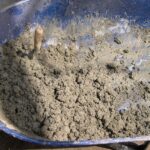Are you into some landscape job that requires dirt filling and you want to know how much does a cubic foot of dirt weight or how much does 1 cubic feet of soil weigh?
Well, at this stage, you need to estimate how much dirt you require and how many trucks you need to be delivered to your location.
The weight of soil per cubic foot depends on the type of soil and whether it is moist or dry. But on average the dirt weighs about 80 pounds per cubic foot with the typical range of 74 to 110 pounds per cubic foot. The dry or loose dirt will weigh around 76 lbs per cubic foot while moist loose dirt will have more weight averaging 78 lbs per cubic foot.
Here’re some typical average weights of soil per cubic foot:
- Dry Loose dirt – 76 lbs per cubic foot
- Moist loose dirt – 78 lbs per cubic foot
- Top soil – 96 lbs per cubic foot
- Dry screened top soil – 44 to 48 lbs per cubic foot
- Dry clay – 100 lbs per cubic foot
- Moist clay – 110 pounds per cubic foot.

The basics of dirt weight
Dirt is a complex mixture of minerals, organic matter, water, air, and remains of decaying living organisms.
The weight of dirt is based on the dry and wet conditions of the topsoil, loose and dense conditions, compaction, particle size and mixture composition, and clay soil that is mixed with rocks, debris, sand, and gravel dirt.
As all dirt is not exactly the same, therefore its weight varies. The weight of dirt cubic per foot depends on the type of dirt, its compaction, and moisture content.
When excavating an area, it is very difficult to tell how much the dirt weighs until we try to figure out what’s in it.
When we buy dirt from the retailer for construction or landscaping, he normally sells us two types of dirt, one is clean fill and the other is topsoil.
The wet dirt weighs a lot more than the dry. When it comes to purchasing dirt, we buy dirt in cubic feet and not in the ton.
But if you buy dirt based on weight, there are chances that you would waste a lot of money. It is very important to understand how much dirt on average weighs for better dealing.
When we are excavating dirt and loading it into a dump truck, we should know that fresh dirt weighs as much as 5%-25% more than clean fill or topsoil because of gravel, clay, stone, and debris.
Also Read: How much does a yard of dirt weigh? (Complete Guide)
Fill Dirt:
The fill dirt is an organic subsoil that contains clay, sand, broken-down rocks, and debris. This is a comparatively fine material that can be used as a place filler. In a construction project, fill dirt is used to give stability to the structure.
For household uses, it can further be processed to remove all organic matter, debris, wood, glass, metal, toxic substance, and flammable materials. Fill can also be categorized as standard fill dirt, clean fill dirt, and structural fill dirt.
Also Read: How many cubic yards are in a dump truck? (Capacity Chart)
Topsoil:
The topsoil is the mineral and nutrient rich top layer of soil found the first 5-12 inches of the earth surface. Top soil is made of varying composition of silt, sand, clay, and looks black due to high levels of organic matter.
This type of soil composition is used to build gardens, fix lawn, and improve drainage.
How much does dirt weigh?
Normally, a cubic foot of dirt weighs between 74 and 110 pounds, depending on the type of soil and moisture content.
How much does dirt weight? : Dry dirt weighs about 76 pounds per cubic foot, whereas moist, loose dirt weighs around 78 pounds per cubic foot. Similarly, a square foot of soil covers approximately 6 square feet of dirt. The weight of clean fill or topsoil is more consistent because it is shifted and cleaned. A cubic foot of dirt is the amount of dirt required to fill a cubic foot of empty space.
A standard dump truck on average can only hold 320-486 cubic feet or 18 cubic yards of fill dirt, which comes out to 20.000 to 24,000 pounds of dirt.
| Topsoil / Material | Average Density (lb. / Cubic Feet) |
| Dirt (loose / dry) | 75 |
| Sand | 95 |
| Rock | 155 |
Steps to Estimate Dirt Volume
To find out how many cubic feet or yards of soil you need for your garden, all you need to do is to take some measurements and do some simple math.
The standard size of 16 feet or 5 meters of tape is not applicable because they are too short, you are going to need a measuring wheel or an outdoor laser measuring tool.
This will help you to get an accurate measurement of your garden and you can precisely find out the dirt requirement.
- Now with the help of a measuring tape, measure the length, width, and depth of the area you want to fill or excavate.
- If you have a large area, it is always good practice to divide the area into smaller areas. Doing this will ease the process of measurement, and secondly, it would give us an accurate measurement.
- Make sure all the measurement that you have taken should be in the same units, usually measurement is taken in feet or meter.
- Then multiply the length, width, and depth to find out the volume in cubic feet.
- If you have divided the area into smaller areas, calculate their volume and then add them to find out the accumulative area.
- You should consider buying dirt in cubic meters or yards. Divide your cubic feet value by 27 and you will get the value in cubic meters or yards.
Also Read: How many yards are in a ton of gravel? (with Online Calculator)
How much a Yard of Dirt weights?
On average a cubic yard of loose dirt weighs around 2100 pounds or 1.05 US tons to cover an area of 100 square feet.
The exact measure depends on various factors including moisture, rock, and debris. On average a cubic yard of topsoil weighs around 1080 pounds depending on moisture and soil content. Excavated dirt is usually well compacted, it may contain gravel, large stones, organic material, clay, and sand.
This means it can weigh a lot more than normal clean topsoil and fill. It is always a good practice to add 5%- 25% more weight. The highly compacted dirt can weigh as much as 3000 lb. per yard even when it is compacted. The density of dirt is 75 pounds per cubic foot.
For Example, we have an area of 50 feet long, with a width of 15 feet, and 7 feet deep. Multiplying all of the three values will give us 5250 cubic feet. Now, if we divide 5250 cubic feet by 27, it will give us 194.5 cubic yards.
How much does a cubic foot of dirt weight?
Depending on the type of dirt and the moisture content, cubic foot of dirt has weight of about 80 pounds that comes as 0.04 short tons. The soil, on the other hand, weighs between 74 to 110 pounds per cubic foot. From these values, the weight of loose dry dirt is less than the moist loose dirt that is 78 lbs per cubic foot.
How many pounds is 1 cubic foot of soil?
If you have a dumper with volume of 1 cubic foot, the soil will have weight of 80 pounds. From these, the dry and loose dirt will have weight of 76 pounds per cubic foot while moist loose dirt has more weight than 78 pounds per cubic foot.
How many pounds is 2 cubic foot of soil?
If you have a dumper with volume of 2 cubic foot, the soil will have weight of 160 pounds. From these, the dry and loose dirt will have weight of 152 pounds per cubic foot while moist loose dirt has more weight than 156 pounds per cubic foot.
How many pounds is 3 cubic foot of soil?
If you have a dumper with volume of 3 cubic foot, the soil will have weight of 240 pounds. From these, the dry and loose dirt will have weight of 228 pounds per cubic foot while moist loose dirt has more weight than 234 pounds per cubic foot.
How many pounds is 5 cubic foot of soil?
If you have a dumper with volume of 5 cubic foot, the soil will have weight of 400 pounds. From these, the dry and loose dirt will have weight of 380 pounds per cubic foot while moist loose dirt has more weight than 390 pounds per cubic foot.
Also Read: How much is an acre in square feet – Acre to sq ft
Final Remarks
There are different types of soil such as sandy soil, clay soil, silty soil, peaty soil, chalky soil, and loamy soil. It is very important to have some basic knowledge of soil so you can decide what type of dirt you are dealing with.
If you know the type of dirt then you can use this information to precisely calculate how much dirt you need to fix your lawn or garden.


















